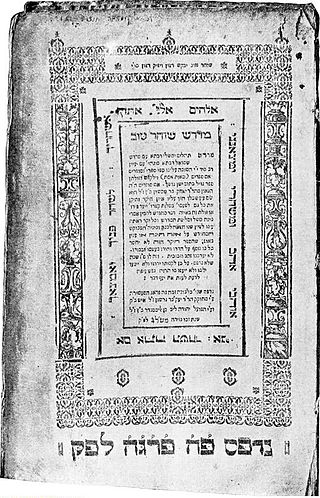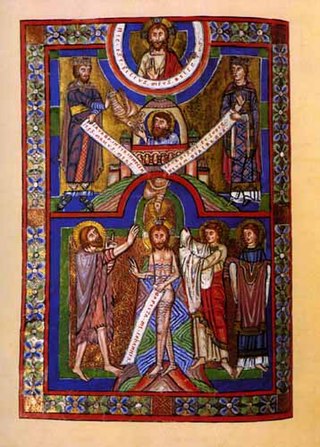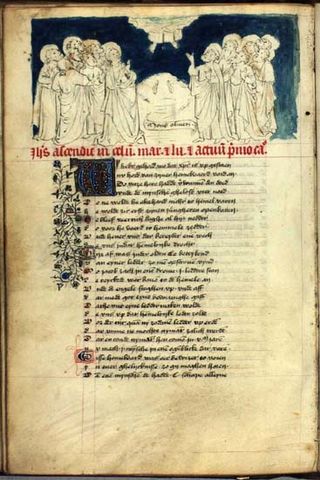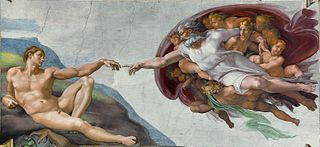
Midrash is expansive Jewish Biblical exegesis using a rabbinic mode of interpretation prominent in the Talmud. The word itself means "textual interpretation", "study", or "exegesis", derived from the root verb darash (דָּרַשׁ), which means "resort to, seek, seek with care, enquire, require".

Hermeneutics is the theory and methodology of interpretation, especially the interpretation of biblical texts, wisdom literature, and philosophical texts. As necessary, hermeneutics may include the art of understanding and communication.

Exegesis is a critical explanation or interpretation of a text. The term is traditionally applied to the interpretation of Biblical works. In modern usage, exegesis can involve critical interpretations of virtually any text, including not just religious texts but also philosophy, literature, or virtually any other genre of writing. The phrase Biblical exegesis can be used to distinguish studies of the Bible from other critical textual explanations.

Nicholas of Lyra, or Nicolaus Lyranus, a Franciscan teacher, was among the most influential practitioners of biblical exegesis in the Middle Ages. Little is known about his youth, aside from the fact of his birth, around 1270, in Lyre, Normandy.
Biblical hermeneutics is the study of the principles of interpretation concerning the books of the Bible. It is part of the broader field of hermeneutics, which involves the study of principles of interpretation, both theory and methodology, for all forms of communication, nonverbal and verbal. While Jewish and Christian biblical hermeneutics have some overlap and dialogue, they have distinctly separate interpretative traditions.

The four senses of Scripture is a four-level method of interpreting the Bible. In Christianity, the four senses are literal, allegorical, tropological and anagogical. In Kabbalah the four meanings of the biblical texts are literal, allusive, allegorical, and mystical.
Biblical literalism or biblicism is a term used differently by different authors concerning biblical interpretation. It can equate to the dictionary definition of literalism: "adherence to the exact letter or the literal sense", where literal means "in accordance with, involving, or being the primary or strict meaning of the word or words; not figurative or metaphorical".
The historical-grammatical method is a modern Christian hermeneutical method that strives to discover the biblical authors' original intended meaning in the text. According to the historical-grammatical method, if based on an analysis of the grammatical style of a passage, it appears that the author intended to convey an account of events that actually happened, then the text should be taken as representing history; passages should only be interpreted symbolically, poetically, or allegorically if to the best of our understanding, that is what the writer intended to convey to the original audience. It is the primary method of interpretation for many conservative Protestant exegetes who reject the historical-critical method to various degrees, in contrast to the overwhelming reliance on historical-critical interpretation in biblical studies at the academic level.

Typology in Christian theology and biblical exegesis is a doctrine or theory concerning the relationship of the Old Testament to the New Testament. Events, persons or statements in the Old Testament are seen as types prefiguring or superseded by antitypes, events or aspects of Christ or his revelation described in the New Testament. For example, Jonah may be seen as the type of Christ in that he emerged from the fish's belly and thus appeared to rise from death.
Anagoge (ἀναγωγή), sometimes spelled anagogy, is a Greek word suggesting a climb or ascent upwards. The anagogical is a method of mystical or spiritual interpretation of statements or events, especially scriptural exegesis, that detects allusions to the afterlife. Certain medieval theologians describe four methods of interpreting the scriptures: literal/historical, tropological/moral, allegorical/typological, and anagogical. The four methods of interpretation point in four different directions: The literal/historical backwards to the past, the allegoric forwards to the future, the tropological downwards to the moral/human, and the anagogic upwards to the spiritual/heavenly.

Allegorical interpretations of Genesis are readings of the biblical Book of Genesis that treat elements of the narrative as symbols or types, rather than viewing them literally as recording historical events. Either way, Judaism and most sects of Christianity treat Genesis as canonical scripture, and believers generally regard it as having spiritual significance.
Pardes is a Kabbalistic theory of Biblical exegesis first advanced by Moses de León, adapting the popular "fourfold" method of medieval Christianity. The term, sometimes also rendered PaRDeS, means "orchard" when taken literally, but is used in this context as a Hebrew acronym formed from the initials of the following four approaches:

Peter of Poitiers was a French scholastic theologian, born in Poitiers around 1125-1130. He died in Paris on September 3, 1205.
Covenantal theology is a distinctive approach to Catholic biblical theology stemming from the mid-twentieth century recovery of Patristic methods of interpreting scripture by scholars such as Henri de Lubac. This recovery was given further impetus by Dei verbum, the Second Vatican Council's "Dogmatic Constitution on Divine Revelation", and consolidated in the section on scripture Catechism of the Catholic Church. These developments gave rise to an approach that emphasizes the "four senses" of scripture within a framework that structures salvation history via the biblical covenants, in combination with the techniques of modern biblical scholarship.
This is a glossary of terms used in Christianity.
Tropological reading or "moral sense" is a Christian tradition, theory, and practice of interpreting the figurative meaning of the Bible. It is part of biblical exegesis and one of the Four senses of Scripture.
Quadriga is a Latin word for a chariot drawn by four horses.
Demythologization as a hermeneutic approach to religious texts seeks to separate or recover cosmological, sociological and historic claims from philosophical, ethical and theological teachings. Mostly applied to biblical texts, demythologization often overlaps with philology, biblical criticism and form criticism. The term demythologization was introduced by Rudolf Bultmann (1884–1976) in existential context, but the concept has earlier precedents.

Many interpreters of Plato held that his writings contain passages with double meanings, called allegories, symbols, or myths, that give the dialogues layers of figurative meaning in addition to their usual literal meaning. These allegorical interpretations of Plato were dominant for more than fifteen hundred years, from about the 1st century CE through the Renaissance and into the 18th century, and were advocated by major Platonist philosophers such as Plotinus, Porphyry, Syrianus, Proclus, and Marsilio Ficino. Beginning with Philo of Alexandria, these views influenced the Jewish, Christian, and Islamic interpretation of these religions' respective sacred scriptures. They spread widely during the Renaissance and contributed to the fashion for allegory among poets such as Dante Alighieri, Edmund Spenser, and William Shakespeare.
Hermeneutics is the theory and methodology of interpretation. The tradition of Western hermeneutics starts in the writings of Aristotle and continues to the modern era.











